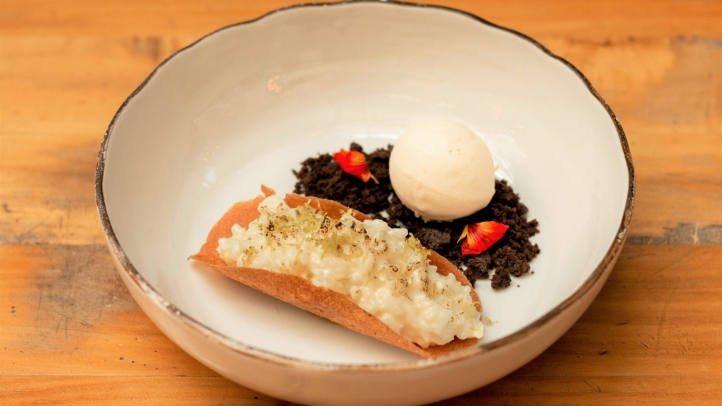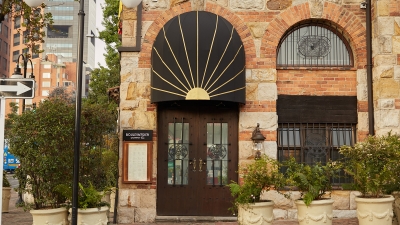Four Seasons Hotel Casa Medina Bogota Puts the History of Spanish Pastry on the Dessert Menu at Castanyoles Restaurant





Whether as a sweet finish, a standalone snack, or something to savour with a cocktail, mocktail, or fresh-brewed Colombian coffee, nothing goes down like picks from the dessert menu of Castanyoles Restaurant. The signature Spanish dining experience occupying an immersive indoor-outdoor expanse with a greenhouse atrium on the ground floor of Four Seasons Hotel Casa Medina Bogota offers an array of treats inspired by Spanish history and popular across Colombia, all refined in line with local tastes, traditions, and fresh ingredients.
Sweet feasts for the eyes as well as for the palate, here are five Spanish-themed pastries for guests and locals to enjoy at the landmark Four Seasons amid the gourmet paradise of Zona G in Bogotá:
Churros with Colombian Chocolate Texture – For a dessert so simple, churros has a complicated history. Noted as “one of the most popular food indulgences of any kind” in by BBC Travel, the dessert is simplicity itself: fried dough piped through a star-shaped pastry funnel. The basic recipe of flour and water has been traced to a Roman cookbook from the 1st century AD. But it was the Spanish, who introduced chocolate to Europe in the early 1500s after conquering the Aztecs, that made churros their own with recipes dating from Moorish Spain in the 1100s, the tradition of dipping in chocolate introduced in the 1800s, and churrería stalls always featured at festivals. The churros on the menu at Castanyoles are perfectly crisped, served with a pitcher of citrus chocolate syrup and a scoop of ice cream in a small, shallow bowl.
Rice Pudding – As every grandmother in Colombia knows, nothing cools a kid’s hunger like a chilled bowl of arroz con leche – rice pudding. A sweet dish loved around the world, especially in Asia where rice is a staple, the traditional Spanish version dressed with cinnamon is believed to have roots in Moorish culture and made its way to South America during the Age of Exploration. Myriad variations exist, including arroz emperatriz mixed with egg yolks, and others sprinkled with sugar for a crunchy, caramelized top. Colombian versions often include grated coconut as an ingredient or garnish, as well as raisins, sometimes soaked in rum or wine. Castanyoles’s take is inspired by tradition, artfully styled in a deep bowl with the pudding spooned in a U-shaped pastry and a scoop of ice cream with edible flowers.
Catalan Coffee Cream – Move over, crème brûlée: traditional Catalan cream infused with coffee is on the menu at Castanyoles. The Spanish version of the popular French dessert – or is it the other way around? – is a simpler treat made from milk instead of cream, flavoured with citrus peel instead of vanilla bean, and prepared in oven-safe dishware without need of a water bath while being caramelized to a sweet crackle. Born in Catalonia in the northeast of Spain, crema Catalana is one of the oldest recorded deserts in Europe, found in a cookbook from 1324. Castanyoles flavours the dish with Colombian coffee tops it with slice strawberries and edible flowers.
Traditional Goxua – If one wants to say something sweet in Basque Country, goxua is a good way to start. Pronounced “go-shoo-a” and translated as “sweet,” the dessert appears on menus in the autonomous north-central region of Spain, particularly in Vitoria-Gasteiz where a local pastry chef claimed to have created it in the 1970s. Similar to and perhaps inspired by crema Catalana, goxua has three layers with a base of whipped cream, a second storey of sometimes-liquor-soaked sponge cake, and a top layer of caramelized custard or caramel sauce. It is often filled with jam and served in a clay pot. Castanyoles puts its own spin on traditional goxua, deconstructing the dessert with large bites of the main ingredients strewn artfully across a plate, some traditional fruits mixed in and a scoop of ice cream.
Spanish Torrija – Essentially the Spanish take on French toast, torrija was said to have been created by nuns as an Easter treat in the 15th century because its protein-like appearance provided relief at a time when meat was forbidden to Catholics. The dessert can also be traced to zalabiyya, a brioche-style bread from the Moorish period of Spain that was fried in oil and sprayed with honey. Often made with leftover bread, enduring flavour options include soaking in milk, syrup, juice, honey, wine, and even soymilk, with a sprinkling of sugar, cinnamon, or both. By the beginning of the 20th century torrija was a common dish served in taverns and bars of Madrid, and it remains popular in the Aragon region of northeast Spain. Castanyoles serves torrija in a deep dish with a side of brown sugar and nuts, peach, a scoop of rum ice cream.
Buen provecho!
Castanyoles serves all-day dining daily from 6:00 am to 10:00 pm. For reservations contact +57 6013257900.




 @FourSeasonsPR
@FourSeasonsPR